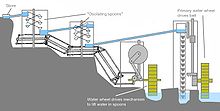Toledo water art
The water art of Toledo was a system built in the 16th century that served to supply the city of Toledo and the Alcázar with water .
initial situation
The water art was a construction by the then famous engineer Juanelo Turriano , who was commissioned during the reign of Charles V to design a device that was able to bring water from the Tagus into the city. Toledo's blacksmiths, famous for their swords and steel products , were in dire need of water for their production, but with the ancient Roman aqueduct destroyed, the tajo water had to be inefficiently transported uphill into town on the back of mules . Turriano's task was to find a mechanical solution to the supply problem.
Construction of the water art
The construction of the complex dragged on over a long period of time and was made more difficult by obstacles such as the abdication of Turriano's patron Charles V in 1556. His successor Philip II was less interested in technical issues than Karl, which meant that the project came to a standstill. In 1565, however, Turriano regained control of the construction and the work was completed. It is not known exactly when the water art was put into operation; but in 1568 it was in use and brought about 12,400 liters of water into the city every day.
The attachment
The completed water art was a complex mechanism capable of transporting the river's water over a height difference of 90 meters and a distance of 600 meters. An undershot water wheel , which also served as a scoop wheel , carried water from the river to a higher tank. At the same time, the waterwheel drove a series of siphons via a precisely constructed linkage, the first of which drew water from the tank. Each of these channels was raised and emptied the water carried along into the next higher channel, which in turn was raised by the rod work. The water was gradually transported uphill until it reached the city and was distributed there via pipes.
business
Although the forge of Toledo suggested the construction and promised Turriano a generous payment of 1900 ducats annually if he successfully provided for their water supply, they stopped paying after five years, although the water art was working perfectly. To justify them, they stated that the Alcázar drew far more water than they did and that they were therefore not obliged to pay the engineer the agreed wages. As a consequence, King Philipp took over the operating costs of the plant and let the blacksmiths shut off the rest of the water supply.
After Turriano's death, his grandson took over the maintenance of the system; when he died too, there was no one left who could maintain the elaborate mechanism. Nevertheless, the water art of Toledo continued to serve for years until it was finally irreparably defective in 1639. The plant was shut down and fell apart. It was in operation for at least 71 years.
reconstruction
No construction drawings or technically reliable descriptions have survived from the water art of Toledo; all contemporary representations are misleading and inaccurate. The science historian Ladislao Reti (1901–1973) tried to reconstruct the facility from the materials available . The illustration opposite shows the result of his work.
literature
- Wilhelm Wölfel: The water wheel - technology and cultural history . Pfriemer, Wiesbaden / Berlin 1987, ISBN 3-7625-2602-8 .

